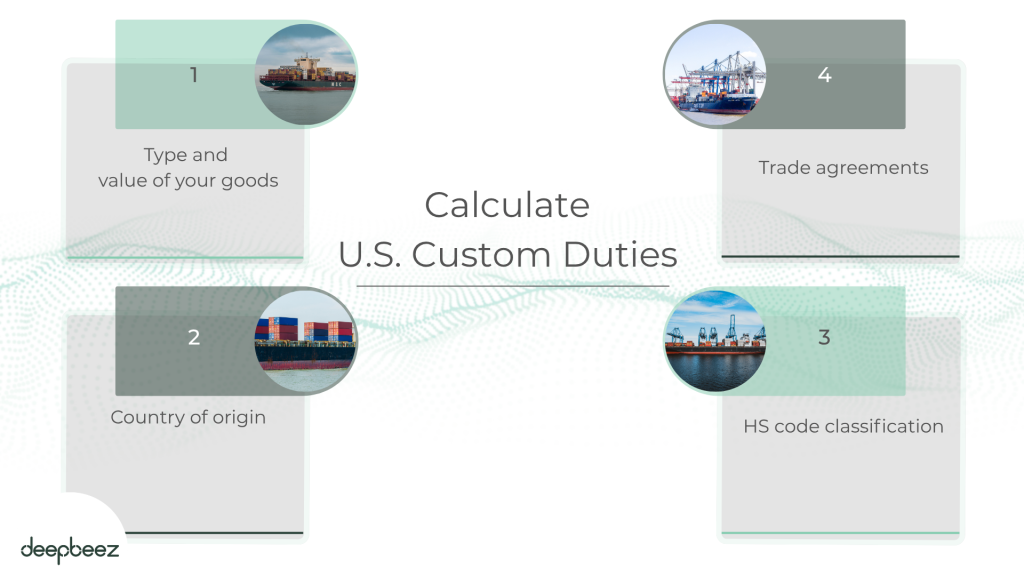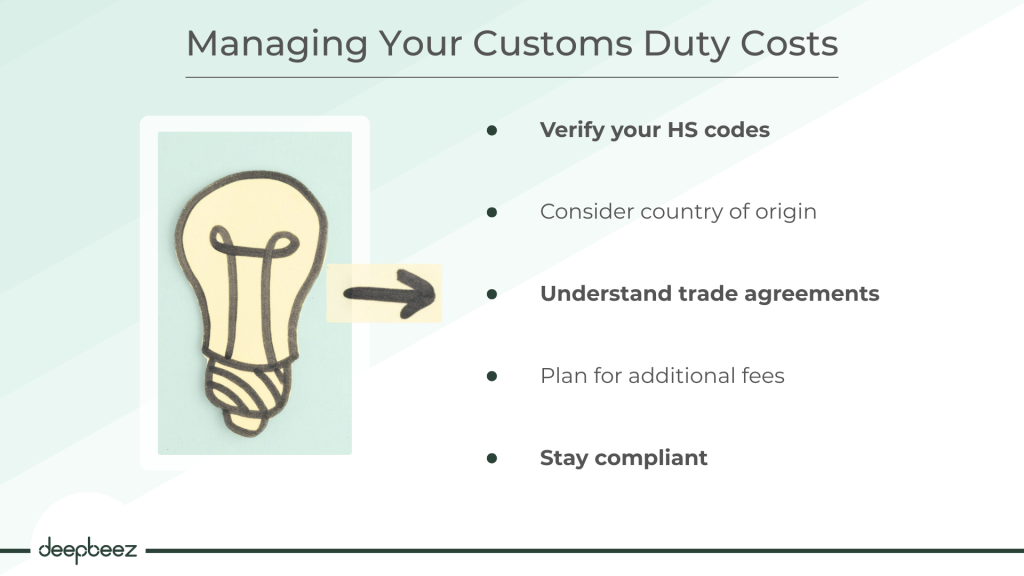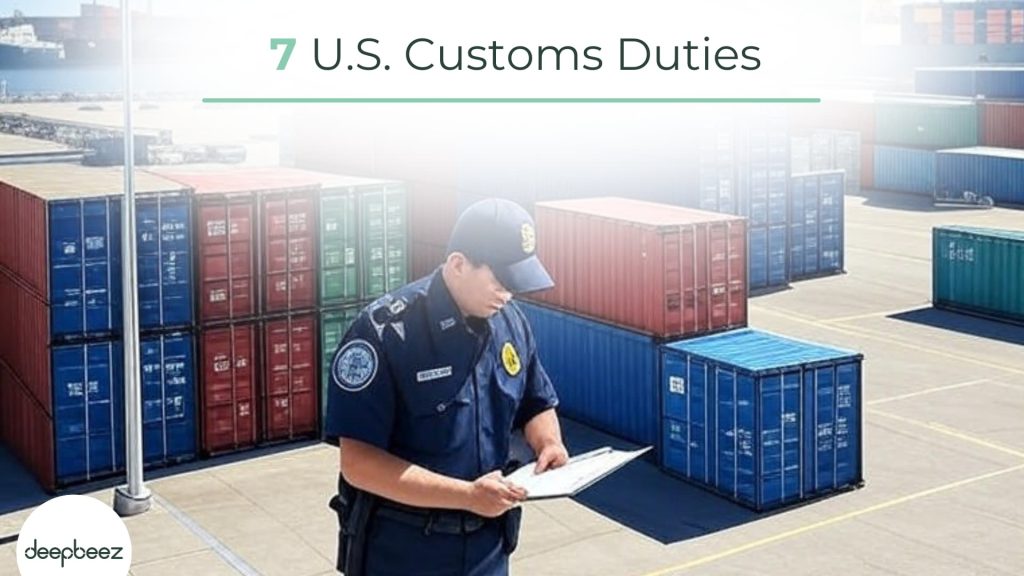Are you planning to import goods into the United States? Whether you’re a small business owner looking to source products internationally or an individual making a personal purchase from overseas, understanding U.S. customs duties can save you from unexpected costs and delays.
If you’ve ever wondered “How much will I pay in customs fees?” or “What exactly are these charges on my import invoice?” – you’re in the right place.
IF you are worried about U.S. custom fees and the most accurate way to calculate duties, you need to find the most accurate HS code for your product first. Deepbeez HS Code Search Tool will help you along the way.
What Is U.S. Customs Duty?
Let’s start with the basics. U.S. customs duty (also called a tariff) is simply a tax that the government charges on goods you import from other countries. Think of it as an entry fee that your products must pay to enter the U.S. market.
How Are Customs Duties Calculated? Before we dive into the different types of duties, let’s understand how the amount you’ll pay is determined. The U.S. Customs and Border Protection (CBP) considers several key factors:
- Type and value of your goods: What are you importing and how much is it worth?
- Country of origin: Where was the product made?
- HS code classification: This is a standardized system that categorizes products worldwide
- Trade agreements: Does the U.S. have special agreements with the country you’re importing from?

What Are All Types of U.S. Customs Duties?
Now, let’s explore the different types of duties you might encounter. Don’t worry – we’ll break each one down so you can easily understand when they apply and how much you might pay.
1- General Import Duties and Tariffs
These are the standard duties that apply to most imported goods. The amount you pay depends on your product’s HS code and where it was made.
Here’s something interesting: the U.S. has free trade agreements with over 20 countries. If your goods come from one of these partner countries, you might pay reduced duties or even zero duty! Countries like Canada, Mexico, and many others benefit from these special agreements.
2- Most Favored Nation (MFN) Tariffs
These are the standard rates applied to shipments from World Trade Organization member countries when no special trade agreement exists.
3- Duties Based on Shipment Value
Did you know that the value of your shipment determines not just how much duty you pay, but also how complex the customs process will be? Here’s how it works:
| Shipment Value | Category | Requirements | Duty Status |
| Under $800 | Section 321 (De Minimis) | Simple process, no bond required | Usually duty-free |
| $800 – $2,500 | Informal Entry | Simpler clearance, bond may be required | General duties may apply |
| Over $2,500 | Formal Entry | Formal process with CBP, customs bond required | Full duties apply |
Sometimes, your goods might be subject to extra duties on top of the general ones. Let’s look at when this happens:
4- USTR Section 301 Duties
Many products from China face additional duties ranging from 7.5% to 25%. These were implemented to address what the U.S. government considers unfair trade practices. Are you importing from China? You’ll want to factor these into your calculations.
5- Anti-Dumping (AD) Duties
These protect American businesses from products sold below their normal value. If a foreign company is “dumping” products at artificially low prices, these duties help level the playing field. If you’re still unsure if you should pay this kind of duty for your product, the article of U.S. anti dumping duties will help you.
6- Countervailing Duties (CVD)
When foreign governments subsidize their companies, allowing them to sell products at unfairly low prices, CVD duties counter this advantage.
Both AD and CVD duties are calculated based on the price difference between the normal value and the export price. For example, if goods normally cost $3,000 but are exported for $1,000, the duty would be $2,000.
7- Additional Taxes on Specific Products
Some products, like alcoholic beverages, face extra taxes beyond regular duties. These vary by product type and are usually calculated per unit or volume.
How Each Type of Duty is Calculated?
Understanding the math behind customs duties can help you budget accurately for your imports. Let’s break down each calculation to find out how to calculate duties or you could simply use Deepbeez U.S. Customs Duties Calculator and get the final rate in just seconds.
1- Core Import Duties/Tariffs
The formula is straightforward: Duty = (Value of goods + Freight + Insurance) × Duty Rate
Remember, if your shipment contains multiple products, CBP calculates duty separately for each item using its specific HS code and rate.
2- Additional Duties Calculation
For Section 301, AD, and CVD duties, the calculation is: Additional Duty = Product Value × Additional Duty Rate
These are added on top of your regular duties, so your total duty becomes: Total Duty = General Duty + Additional Duties
3- Other Important Import Fees (Beyond Duties)
While not technically “duties,” several other fees contribute to your total import costs. Understanding these helps you budget accurately:
| Fee Type | Calculation | Purpose |
| Merchandise Processing Fee (MPF) | 0.3464% of entered value (Min: $31.67, Max: $614.35) | Processing your customs entry |
| Harbor Maintenance Fee (HMF) | 0.125% of entered value (ocean shipments only) | Maintaining U.S. ports |
| Customs Bond | Varies by type and shipment value | Guarantees payment of duties |
| Broker Fees | $100-$150 for basic entry | Professional customs clearance |
| Inspection Fees | $300 for X-ray, $1,000+ for physical exam | Cargo examination costs |
4- Customs Bond
Customs bonds deserve special attention because they’re required for most shipments over $800. Think of a bond as insurance that guarantees you’ll pay your duties and follow all regulations.
You have two options:
- Single-Entry Bond: Covers one shipment (about $75 for ISF + 0.45-0.5% of shipment value)
- Continuous Bond: Covers all shipments for a year (about $500 for a $50,000 bond)
Which makes more sense for your business? If you’re importing regularly, a continuous bond usually offers better value.
Common Import Scenarios and Costs
Let’s look at some real-world examples to help you understand how these calculations work:
| Scenario | Shipment Value | Country | Estimated Total Costs |
| Small personal purchase | $300 | Any country | $0 (under de minimis) |
| Small business order | $1,500 | Canada (NAFTA partner) | MPF + broker fees (~$150) |
| Standard import | $10,000 | China | Duties + Section 301 + MPF + HMF + fees (~$1,500-3,000) |
| Large commercial shipment | $50,000 | Germany | Duties + MPF + HMF + bond + fees (~$2,000-6,000) |
These examples show how costs can vary dramatically based on your specific situation.
Tips for Managing Your Customs Duty Costs
Want to minimize your customs expenses? Here are some practical strategies:
- Verify your HS codes: Using the correct classification can save you money and avoid penalties. Use Deepbeez HS Code Search Tool to minimize the risk.
- Consider country of origin: Sometimes sourcing from FTA partner countries can reduce duties
- Understand trade agreements: Take advantage of preferential rates when available
- Plan for additional fees: Budget for MPF, HMF, and broker fees beyond just duties
- Stay compliant: File all required documents on time to avoid $5,000+ penalties
- Remember that
Have you checked if your products qualify for any duty reductions under existing trade agreements?

Necessary Documents for U.S. Customs Duties
For a seamless U.S. customs clearance process, proper documentation and timely paperwork are essential. Incomplete or incorrect documentation can lead to customs delays.
| Document Type | Description | Key Requirements | Additional Notes |
| Commercial Invoice | Mandatory document signed by shipper/seller for every shipment | Must include all details per Tariff Act: • Exporter/Shipper Name & Address • Seller Name & Address (if different) • Consignee Name & Address • Buyer Name & Address (if different) • Invoice Number & Date of Shipment • Country of Origin • Detailed Description of Goods (material composition, intended use, grades, quality, part numbers) • Quantity, Weight, and Measurements • Value of Goods & Total Invoice Value • Currency of Transaction • Terms of Sale (Incoterms: FOB, CIF, etc.) • HS Code (Harmonized System Code) • Shipping Terms & Carrier Name • EIN or SSN of U.S. consignee/buyer • Origin of Shipment & Port of Entry • All Charges Incurred (insurance, freight, packing) • Packing List Reference (if applicable) • Exporter’s declaration certifying truth and correctness | • Must be in English or include English translation • Each shipment generally requires separate invoice • Assembled shipments or installments can use single invoice |
| Bill of Lading (BoL) | Document of receipt from forwarder/vessel operator | • Acts as contract for freight transportation • Evidence of right to make U.S. entry • Must be submitted when filing entry with CBP | • Also known as BoL, B/L, or Waybill • For air shipments: Air Waybill (AWB) used instead |
| ISF Filing (Importer Security Filing) | Form submitted by importers or assigned brokers to CBP | • Must be filed at least 24 hours before cargo loaded on vessel • Contains important freight details for CBP inspection determination | • Can be downloaded from CBP website • Used by CBP to determine if cargo needs further inspection |
| Arrival Notice | Issued by carrier when goods arrive at port | • Notifies consignee, notify party, or customs broker • Informs that goods are ready for next customs clearance steps • Includes shipment details and location | • Triggers next phase of customs process |
Filing Requirements
| Requirement | Details |
| Filing System | All entry documents must be filed through Automated Broker Interface (ABI) within Automated Commercial Environment (ACE) – CBP’s tracking and processing system |
| Filing Deadline | All entry documents must be filed with CBP within 15 calendar days from shipment arrival |
Additional/Special Documents
| Document Category | When Required | Details |
| Partner Government Agency (PGA) Approvals | Depending on goods type | • FDA approval forms (food items) • USDA approval forms (agricultural products) • CPSC approval forms (hazardous equipment/chemicals) |
| Power of Attorney | When using customs broker services | Grants customs broker right to facilitate clearance process on your behalf |
Record-Keeping Requirements
| Requirement | Duration | Purpose |
| General Import Documents | Several years post-shipment | CBP may request for re-verification at any time |
| Countervailing & Antidumping Duty Goods | Minimum 5 years | Enhanced compliance requirements |
| Compliance Importance | Ongoing | Non-compliance can result in fines and penalties |
FAQ
- Do I have to pay customs duties on packages under $800?
No, packages valued under $800 are eligible for the de minimis exemption and enter duty-free under Section 321. However, this doesn’t apply to Chinese imports as of May 2025. - Why did I get charged duties on my $50 package from China?
Since May 2, 2025, all Chinese imports (including Hong Kong) are no longer eligible for the $800 duty-free exemption due to Executive Order 14256. Duties now apply to all Chinese goods regardless of value. - What’s the difference between importing for personal use vs. business?
Personal imports under $2,500 can use informal entry procedures, while commercial imports typically require formal entry with more documentation. Commercial merchandise over $2,500 requires customs bonds. - How do I find the duty rate for my product?
Use the Harmonized Tariff Schedule (HTS) to find your product’s classification code and duty rate. The rate is usually a percentage of the product’s value. - Can I avoid duties by marking my package as a gift?
Gifts from foreign countries are duty-free only up to $100 ($200 from US territories). Above these amounts, regular duties apply. - Do I need a customs broker for small imports?
You should contact a customs broker if your product may be subject to restrictions, quotas, or if you’re unsure about requirements. For simple imports under $2,500, it’s often not required. - What’s the Merchandise Processing Fee (MPF)?
The MPF is 0.3464% of the imported goods’ value, with a maximum of $614.35. It covers customs administration costs and is charged in addition to duties. - Can I get a refund on duties I already paid?
Yes, through duty drawback you can recover duties on goods that are re-exported, used in manufacturing for re-export, or destroyed. - What documents do I need for importing?
For all cargo: commercial invoice, bill of lading/air waybill, and customs bond (for goods over $2,500). Additional permits may be required for specific products. - Are there additional tariffs on top of regular duties?
Yes, as of 2025, there’s a 10% Baseline Tariff on imports from countries without US trade agreements, plus potential reciprocal tariffs. These stack on top of standard HTS duties. - How are duties calculated on used items I buy online?
It doesn’t matter if items are new or used – all imported merchandise must clear customs and may be subject to duties based on their value and classification. - What happens if I use the wrong HTS code?
Misclassifying items can result in hefty penalties. Always double-check HTS codes and ensure accuracy. You may need to pay additional duties or face delays. - Can I split shipments to stay under the $800 limit?
No, CBP specifically prohibits breaking down shipments to obtain duty-free treatment and may combine multiple same-day shipments to the same recipient. - Do digital downloads have customs duties?
No, materials electronically transmitted (like digital music, ebooks, or software downloads) are not subject to duties. - What’s the difference between formal and informal entry?
Informal entry is for items under $2,500 where CBP prepares the paperwork. Formal entry is required for higher-value shipments and requires more documentation. - Are there special rules for mail packages?
Yes, packages under $800 through international mail are generally cleared without additional paperwork, and those under $2,500 receive simplified “mail entry” processing. - Can I save money with free trade agreements?
Yes, products from countries with US free trade agreements (like USMCA) may qualify for reduced or zero duties if they meet origin requirements. - What are anti-dumping duties and how do I know if they apply?
Anti-dumping duties counteract unfairly priced imports. Check CBP’s ADD/CVD search page to see if your specific product and country combination is subject to these duties. - Do I need export licenses to ship goods out of the US?
Some exports require licenses from the Bureau of Industry and Security (BIS). Check if your product falls under export control categories. Always verify restricted parties and countries. - How can I pay customs duties and fees?
You can pay CBP duties through ACH, check, or other approved methods. Your carrier or customs broker typically handles payment and then bills you.





